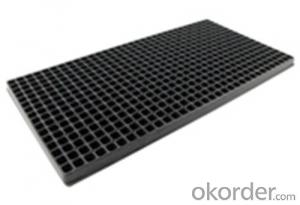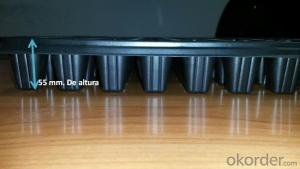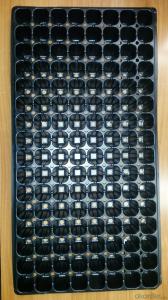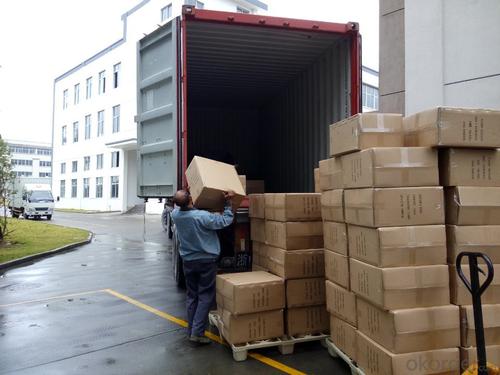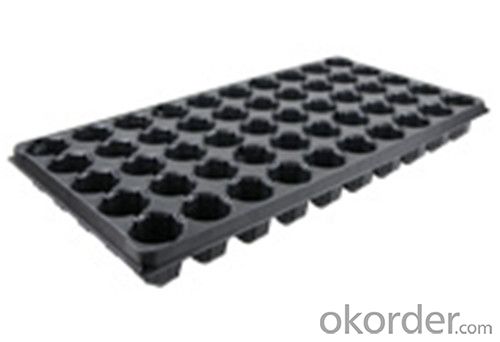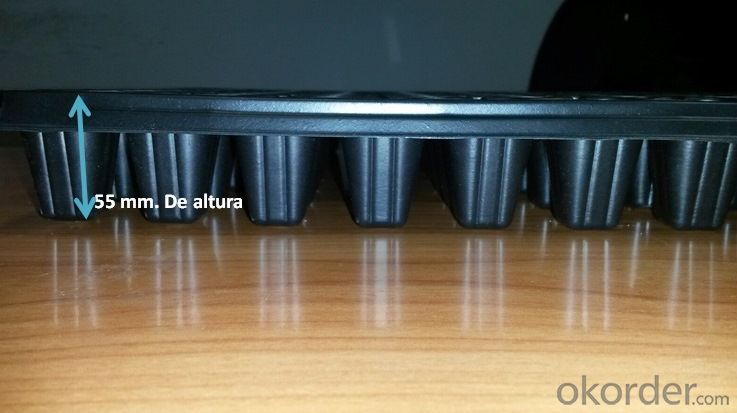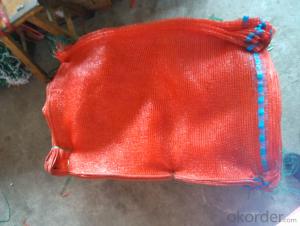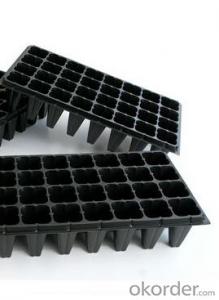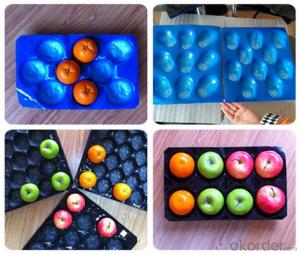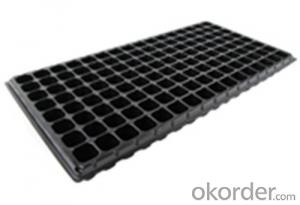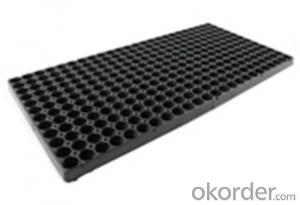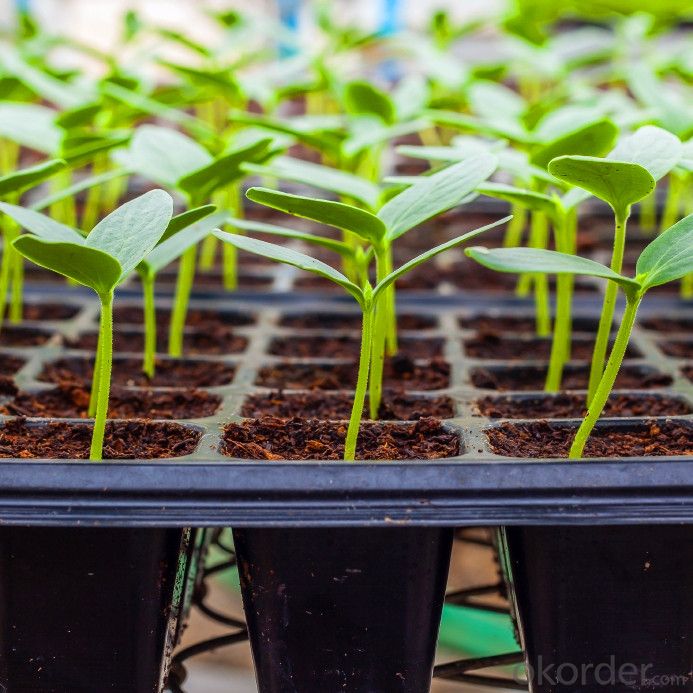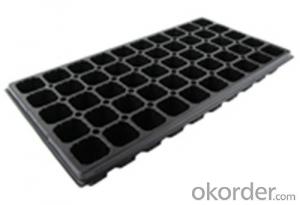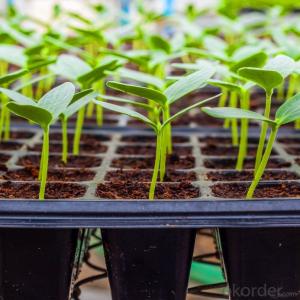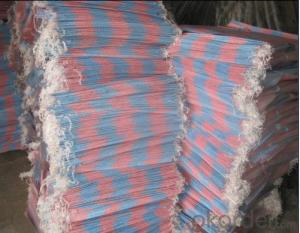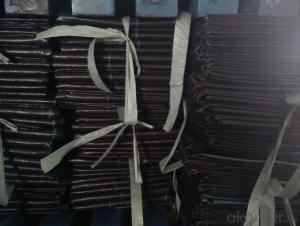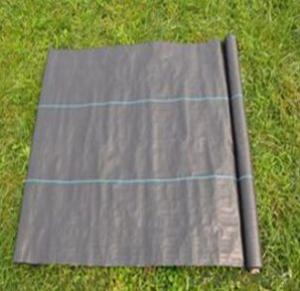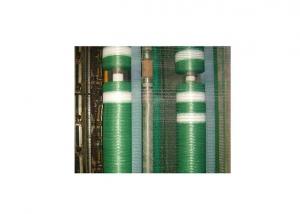Square Nursery Seeding Tray PS Seed Tray Plastic Tray
- Loading Port:
- China main port
- Payment Terms:
- TT OR LC
- Min Order Qty:
- 3000 pc
- Supply Capability:
- 10000000 pc/month
OKorder Service Pledge
OKorder Financial Service
You Might Also Like
Structure of the seed tray: · Top quality and competitive price. · Variety design and good appearance. · Easy to use, and remove. · Durable and reusable. · Eco-Friendly.
Advantages: · Top quality and competitive price. · Variety design and good appearance. · Easy to use, and remove. · Durable and reusable. · Eco-Friendly.
Application: · Ideal for Starting seeds and Transplanting Seedling. · Suitable for both manual and automatic planting. · Suitable for Propagating Vegetables, Flowers and other plant from seed · in green-house or indoors.
Description Main Features of the seed tray: · Ideal for Starting seeds and Transplanting Seedling. · Suitable for both manual and automatic planting. · Suitable for Propagating Vegetables, Flowers and other plant from seed in green-house or indoors. Using time: · thickness of 0.5mm can be used 1 to 2 times. · thickness of 0.6mm can be used 3 to 4 times. · thickness of 0.7mm can be used 5 to 6 times. · thickness of 0.8mm can be used 7 to 8 times. · thickness of 0.9mm can be used 8 to 9 times. · thickness of 1.0mm can be used 8 to 10 times. Thickness vs. Weight: · Thickness of trays are from 0.5mm to 1.0mm. · 1.0mm: 155g±5g; 100pcs/ctn. · 0.9mm: 140g±5g; 120pcs/ctn. · 0.7mm: 110g±5g; 150pcs/ctn. · 0.6mm: 95g±5g; 180pcs/ctn. · 0.5mm: 80g±5g; 200pcs/ctn.
FAQ: Q:How Can I Get A Sample? A:You can get samples by communicate with our export sales. Q:How Long Is Delivery? A:Delivery time will be 7-25 days according to order quantity. Q:What Is The MOQ? A:Our MOQ is 1*20FT container quantity, allow to mix several items. Q:What Is Our Normal Payments Terms? A:Our normal payment terms now is T/T, L/C or Western Union,Papal. Q:How Do I Order Your Products? A:You can check our website for any items you interest and you can also get communication with our export sales and order for it accordingly. Q:What Kinds Of Material We Use In Our Product? A:Our plastic flower pots use material such as PP polymer or PE polymer.
|
- Q: Explain the distinctions between the use of plastic mulch in agriculture versus farming without mulch.
- <p>Agricultural plastic mulch farming involves the use of plastic sheets to cover the soil, which helps in weed control, retains soil moisture, and can increase soil temperature. This method can lead to earlier crop maturity and higher yields. Non-mulch farming, on the other hand, does not use plastic sheets, relying instead on traditional methods of weed control, such as tillage or manual removal. Non-mulch farming might be more susceptible to soil erosion, have less moisture retention, and potentially lower yields compared to mulch farming. Additionally, plastic mulch can contribute to environmental concerns due to the non-biodegradable nature of plastics, whereas non-mulch farming avoids these issues.</p>
- Q: Like the question says, what are the uses of plastics in semiconductors.??
- difficult matter. look on the search engines. just that can assist!
- Q: How does agricultural plastic affect crop frost protection?
- Agricultural plastic can significantly enhance crop frost protection by acting as a barrier against freezing temperatures. It helps create a microclimate around the plants, trapping heat and reducing heat loss. This protective layer prevents the formation of frost on crops, minimizing damage and ensuring their survival during cold weather conditions.
- Q: Are nursery trays suitable for succulent arrangements?
- Yes, nursery trays can be suitable for succulent arrangements as they provide a convenient and efficient way to grow and display multiple succulents in a compact space. The trays often come with drainage holes, which are crucial for preventing water accumulation and ensuring proper succulent growth. Additionally, nursery trays are usually made of durable materials that can withstand the weight and unique needs of succulents. However, it is essential to ensure that the tray is well-draining and has enough space for each succulent to thrive individually.
- Q: What are the best ground cover plants for full sun?
- Some of the best ground cover plants for full sun include creeping thyme, sedum, creeping phlox, and ice plant. These plants are known for their ability to thrive in direct sunlight, form dense mats, and provide attractive foliage and flowers.
- Q: What are the best ground cover plants for erosion control?
- Some of the best ground cover plants for erosion control include creeping juniper, English ivy, pachysandra, creeping phlox, and vinca minor. These plants have spreading growth habits, dense root systems, and excellent soil retention capabilities, making them effective in preventing soil erosion.
- Q: What are the recent advancements or innovations in the field of agricultural plastic products?
- <p>Recent developments in agricultural plastic products include the use of biodegradable plastics, advancements in mulching films, and smart greenhouse technologies. Biodegradable plastics are being developed to reduce environmental impact, with materials like PLA (polylactic acid) and PHA (polyhydroxyalkanoates) gaining attention. Mulching films have improved to enhance crop growth, water retention, and soil health. Additionally, smart greenhouses with integrated plastic components are becoming more sophisticated, offering automated climate control and energy efficiency. These advancements aim to increase agricultural productivity while minimizing environmental harm.</p>
- Q: This question asks whether biodegradable mulch films can be recycled and reused, indicating a concern for environmental sustainability.
- <p>Biodegradable mulch films, while designed to break down naturally over time, can be challenging to recycle due to their specific composition and the presence of organic materials. Traditional recycling processes, which are often optimized for non-biodegradable plastics, may not be suitable for these films. However, some manufacturers are developing new technologies to recycle biodegradable plastics, including mulch films. Reuse of these films is also limited because once they start to degrade, their effectiveness as a mulch diminishes. Therefore, while the concept of recycling and reusing biodegradable mulch films is environmentally appealing, current practices and technology have limitations that prevent widespread recycling and reuse.</p>
- Q: Can agricultural plastic products be used for windbreaks?
- Yes, agricultural plastic products can be used for windbreaks. They are commonly employed as windbreak fencing to protect crops, livestock, or farm buildings from strong winds. Agricultural plastic windbreaks effectively reduce wind velocity, prevent soil erosion, and offer protection against wind damage, making them a practical choice for agricultural applications.
- Q: Do nursery trays have dividers?
- Yes, nursery trays often have dividers to separate and organize different plants or seedlings.
Send your message to us
Square Nursery Seeding Tray PS Seed Tray Plastic Tray
- Loading Port:
- China main port
- Payment Terms:
- TT OR LC
- Min Order Qty:
- 3000 pc
- Supply Capability:
- 10000000 pc/month
OKorder Service Pledge
OKorder Financial Service
Similar products
Hot products
Hot Searches
Related keywords


